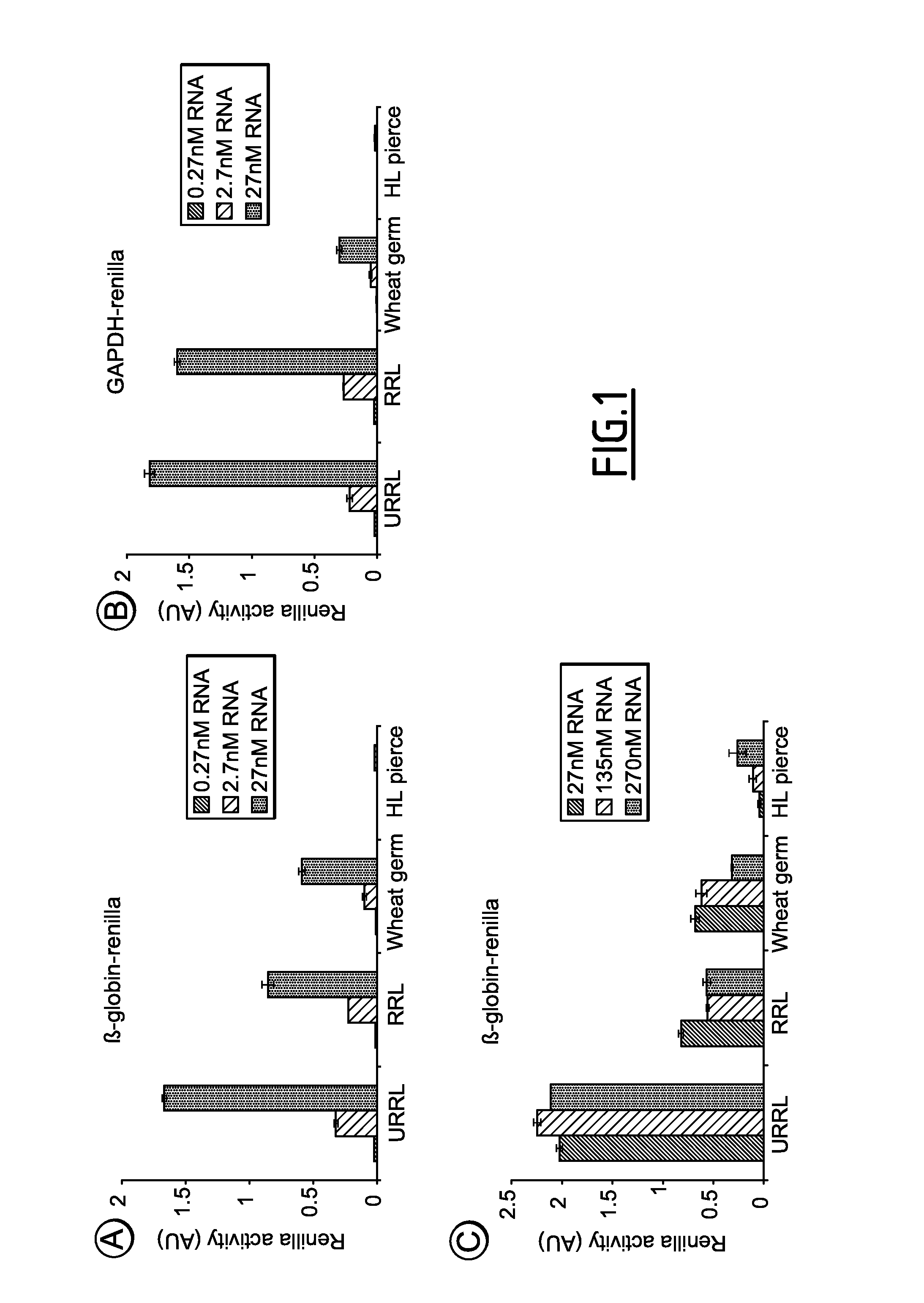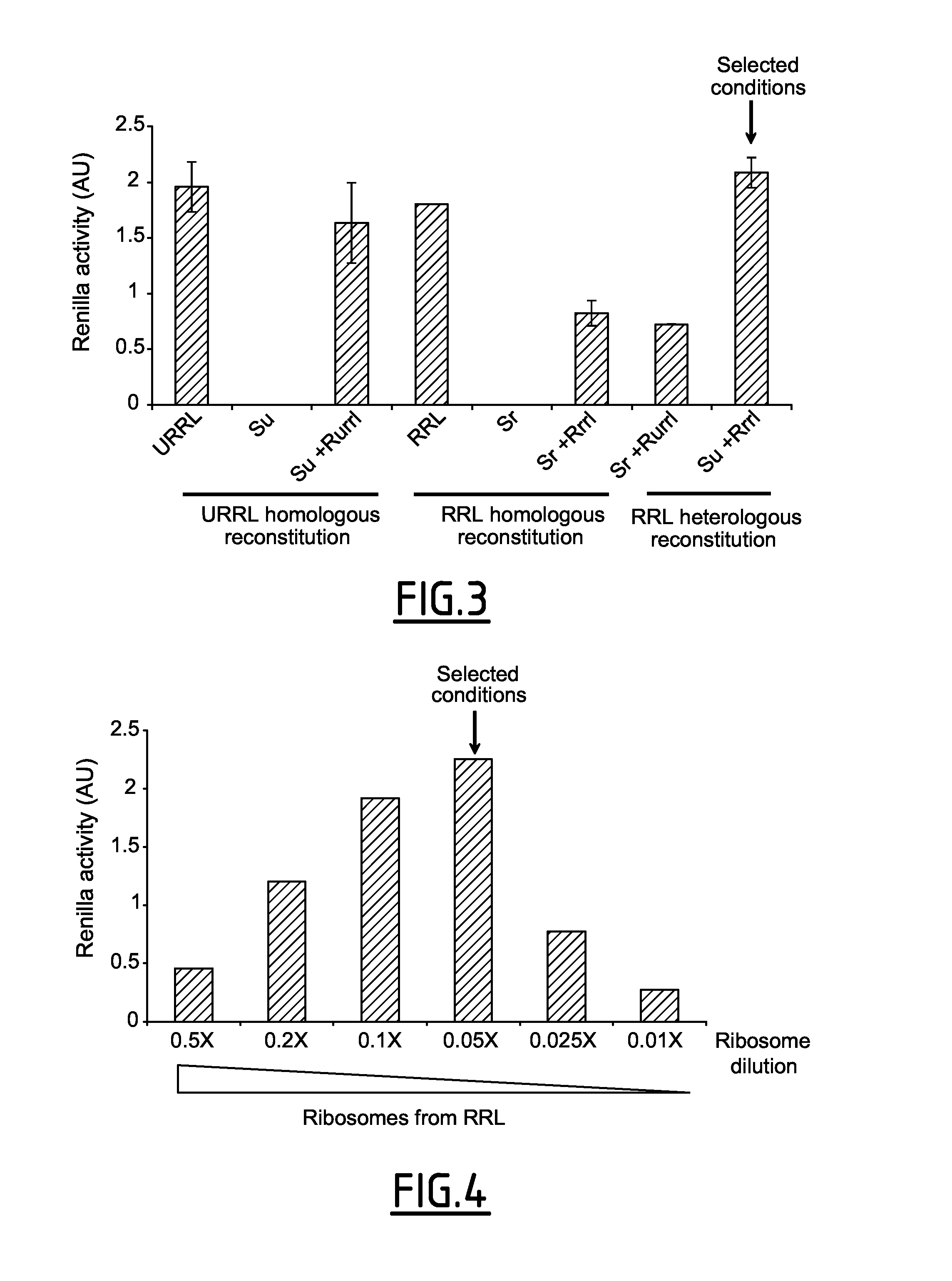Cell-Free Translation System
a cell-free, translation-free technology, applied in the field of cell-free translation-free system, can solve the problems of insufficient study of the pathway of mammalian translational control, insufficient enzymology, inability to produce protein, etc., and achieves the effect of not being able to achieve the yield of protein produced, not being able to achieve the effect of enzymology, and being easy to mak
- Summary
- Abstract
- Description
- Claims
- Application Information
AI Technical Summary
Benefits of technology
Problems solved by technology
Method used
Image
Examples
example 1
Materials and Methods
[0196]DNA Constructs
[0197]The globin, GAPDH, PV, HIV1, c-myc 5′UTR, EMCV, CrPV and Utrophin 5′UTRs were obtained by PCR using the p0-glo-renilla, p0-GAPDH-renilla p0-EMCV-renilla, p0-PV-renilla, p0-HIV1-renilla, p0-CrPV-renilla (Soto Rifo et al., Nucleic Acids Res., 35(18): e121, 2007; Soto-Rifo et al., Nucleic Acids Res., 2011; Soto-Rifo et al., Embo. J., 31(18): 3745-3756, 2012), c-myc pRMF (Evans et al., Oncogene, 22(39): 8012-8020, 2003), pGL4.14CMV 5′UTR mUTROPHIN (Miura et al., J. Biol. Chem., 280(38): 32997-33005, 2005) respectively using specific primers containing PvuII restriction site and T7 promoter and HpaI restriction site (for sense primers) and BamHI restriction site (for antisense primers). PCR products were digested and cloned in p1-renilla and pCDNA3.1-renilla backbone vectors previously digested by PvuII and BamHI or HpaI and BamHI restriction enzymes respectively. The pCDNA3.1 vector was modified after the CMV promotor to minimize the number...
example 2
Comparison of Translational Efficiency in Some CFPS
[0228]Given the diversity of in vitro translation systems, the inventors wanted to compare the most commonly used ones such as the rabbit reticulocyte (treated or not with the S7 nuclease), the wheat germ and the newly available Human lysates from Pierce which is prepared from HeLa cell extracts. For each of these lysates, their ability to translate in vitro transcribed mRNAs has been monitored. The renilla luciferase whose expression was driven either by the β-globin (50 nts) or the GAPDH (102 nts) 5′ untranslated region (5′UTR) was used. These RNA constructs harbor a m7GTP cap moiety together with a 50 adenylate residue poly(A) and were translated in either the crude rabbit reticulocyte lysate (URRL), the micrococcal treated rabbit reticulocyte lysate (RRL), the wheat germ lysate (WG) and the human in vitro protein expression system (HL pierce). Results obtained are summarized in FIG. 1A for the mRNA that is driven by the β-globin...
example 3
Design of a Novel Hybrid In Vitro Translation System
[0229]The aim of the invention was to design a novel in vitro cell free system that can combine translational efficiency and characteristic features of living cells. To do that, the creation of a hybrid translational system between components of the rabbit reticulocyte lysate with those derived from cultured cells has been considered.
[0230]In order to do this, the inventors first adapted the method developed by Rau et al, in 1998 which consists of fractionating the rabbit reticulocyte lysate into a S100 supernatant and the ribosomal pellet (Rau et al., Methods Mol Biol 77: 211-226, 1998) by centrifuging at 240 000 g for 135 mn. It resulted in the separation of the cytosolic components of the protein synthesis apparatus from ribosomes associated one: both fractions could be rapidly frozen and stored at −80° C. for several months (see FIG. 2 and materials and methods).
[0231]In a first attempt, the inventors mixed components from the ...
PUM
| Property | Measurement | Unit |
|---|---|---|
| pH | aaaaa | aaaaa |
| pH | aaaaa | aaaaa |
| volume | aaaaa | aaaaa |
Abstract
Description
Claims
Application Information
 Login to View More
Login to View More - R&D
- Intellectual Property
- Life Sciences
- Materials
- Tech Scout
- Unparalleled Data Quality
- Higher Quality Content
- 60% Fewer Hallucinations
Browse by: Latest US Patents, China's latest patents, Technical Efficacy Thesaurus, Application Domain, Technology Topic, Popular Technical Reports.
© 2025 PatSnap. All rights reserved.Legal|Privacy policy|Modern Slavery Act Transparency Statement|Sitemap|About US| Contact US: help@patsnap.com



